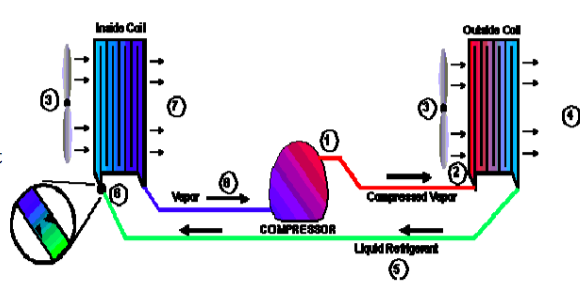Air conditioning is really pretty simple when you get down to the basics. It is a sealed system composed of copper tubing, some electronics, and three basic components. A compressor and two heat exchangers or coils.
In Florida we typically find “Split systems” with the compressor and condenser coil located outside the home and the metering valve and evaporator inside the homes garage, closet or attic. The refrigerant vapor enters the outside coil (condenser) (2) where a fan (3) blows air across it. This cools the refrigerant by removing heat (4) and condenses it to liquid. This is the same as when steam is cooled. It will condense to liquid water.
 The cycle goes like this;
The cycle goes like this;
- The compressor (1) compresses the refrigerant into high pressure vapor.
- The refrigerant which is now liquid (5) is pushed along the refrigerant line to the inside coil (evaporator) where it encounters a metering device.
- The metering device (6) limits the amount of refrigerant entering the inside coil (evaporator) and creates a pressure drop across it.
- This allows the refrigerant to expand from a small diameter tube to a larger one.
- At this coil a fan (3) blows air across it and the refrigerant absorbs the heat in the air. This effectively
- cools the air exiting the coil (7) and the heat evaporates the refrigerant back to vapor.
- As the warm air passes over the cool coil moisture in the air condenses, and drips into a collection pan
- and is drained to the exterior. This removes humidity from the interior air as well as cooling it.
- From here the refrigerant vapor (8) returns to the compressor to start the cycle over again.
So to summarize, the air releases heat energy to the refrigerant (cooling the air) at the inside (evaporator) and the refrigerant releases that heat energy into the air at the outside coil (condenser). It all boils down to hot air blowing out of the outside coil (condenser) and cool air blowing out of the inside coil (evaporator) (usually ducted to the rooms in the home).
A brief history of Air Conditioning.
In 1820, British inventor Michael Faraday discovered that compressing and liquefying ammonia could chill air when the liquefied ammonia was allowed to evaporate. In 1842, Florida physician Dr. John Gorrie used compressor technology to create ice, which he used to cool air for his patients in his hospital in Apalachicola, Florida. He could not get financial backing to improve his system and air conditioning languished for 50 years. In 1902 the first modern electrical air conditioning was invented by Willis Haviland Carrier but was primarily used in commercial applications. Over time air conditioning came to be used to improve comfort in homes and automobiles. Residential sales expanded dramatically in the 1950s.
What does that mean?
What is a SEER rating?
Cooling efficiency for air conditioners and heat pumps is indicated by a SEER (Seasonal Energy Efficiency Ratio) rating, which tells you how efficiently a unit uses electricity. The higher the number, the greater the efficiency.
The typical SEER rating of units manufactured prior to 1992 is about 6. In 1992, the government established the minimum cooling efficiency standard for units installed in new homes at 10 SEER. The present standard is 13 SEER. High-efficiency units have a SEER of at least 12; the maximum available is about 17. Replacing a 9 SEER system with a 13 SEER system could reduce power consumption by 30%.
<2>What is a Ton?
Air conditioner equipment power is often described in terms of "tons of refrigeration". A "ton of refrigeration" is defined as the cooling power of one ton (2000 pounds) of ice melting in a 24-hour period. This is equal to 12,000 BTU per hour, or 3517 watts. Residential "central air" systems are usually from 1 to 5 tons (3 to 20 kW) in capacity. It is typically considered that one ton of power will cool a 500 sq ft area. This can vary greatly due to volume (ceiling height), percent of glass and type of insulation in walls.
What is Refrigerant?
The refrigerant is the medium used to transfer heat from the inter to the exterior thus cooling the interior. "Freon" is a trade name for a family of haloalkane refrigerants (CFC) manufactured by DuPont and other companies. These refrigerants were commonly used due to their superior stability and safety properties. It is thought that the chlorine in escaping CFC’s contribute to Ozone depletion in the atmosphere. In 1996 their use was banned and they were replaced with HCFC (commonly called R-22) which is currently being replaced with hydrofluorocarbons (HFCs), such as R-410A, which lack chlorine.
What is a Humidistat?
In some homes a Humidistat is incorporated into the thermostat or found next to it. The Humidistat will turn on you’re A/C system when a certain humidity level is detected as opposed to temperature which is detected by the thermostat. For our seasonal residence this can provide an energy savings in the summer when the home is not occupied. Temperature levels can be kept at a higher level than we typically find comfortable and because we are not cooking, showering, opening doors, etc. the humidity levels will rise slowly. By properly setting these devices (example 80° and 60%) the system will operate less, saving money, yet still keeping humidity levels below those where mildew and mold can form. The proper settings for theses devices is determined by how they are wired to each other and may have to be explained by you’re A/C mechanic. For more information see
What is a Matched Split System?
A split system has an exterior and an interior component and is the most common type of system found in our area. These two systems are designed to function together. Although initially less expensive replacing only one of the components with a different brand or one that is not matched to the other component can decrease performance, shorten the life of both components and increase cost over the long run.
What is a Heat Pump?
A Heat Pump System operates essentially in the same manner as a Matched Split System. The major difference is a “reversing valve” which allows the system to reverse the flow of the coolant. This allows the system to collect heat at the condensation coil (outside) and release it at the evaporator coil (inside) warming the interior air. A Heat Pump heats the interior air more efficiently than an air conditioner with an electric coil heating element but is also more expensive and will not perform well in extreme cold. They are typically found from mid Florida to Maryland.
What other types of units are commonly found in this area?
In some of our connected condominiums (typically 4 pack units) a Package System may be used. All components are outside the building in one “package” typically mounted on the roof or side of the structure. In larger “tower” condominiums Water Source Heat Pumps may be used. All of the A/C components are in one package typically located in a closet. Instead of expelling excess heat to the outside air it is transferred in water pipes to an evaporator tower typically located on the roof. This common tower serves all the units and water flows down a stair like structures allowing the heat to escape to the air.
What is a Two Stage System?
A single stage air conditioning system is either on or off. A two-stage system operates more like your ceiling fan – completely off, all the way on, or at a medium speed. If your home is extremely warm, a two-stage air conditioner will use the higher speed, but if only a little cooling is needed it will use a more energy-efficient lower speed. Any new A/C system will be much more efficient than your old air conditioner but there is a significant difference in energy efficiency between single a and two-stage air system. Air conditioners are more efficient when they stop and start less frequently. Single-stage systems run at 100% capacity which can cause frequent starts and stops (called short cycling). Two-stage air conditioners, on the other hand, can use a lower setting. A two-stage air conditioner will actually run longer than a single-stage, but use less energy because it is at a lower speed.




















